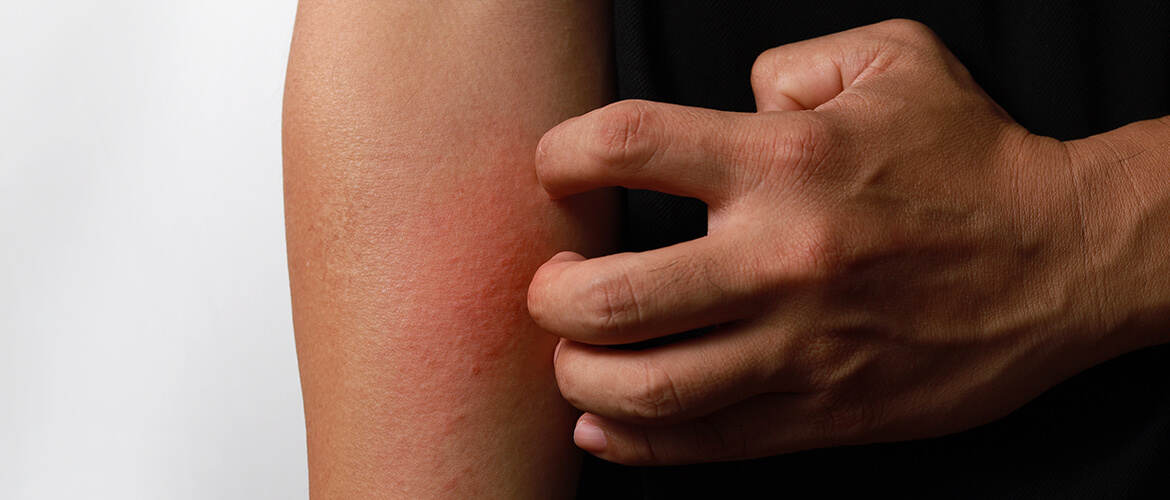Most of us are no strangers to fungal skin infections. Chances are you know of someone or have perhaps even experienced a case of Athlete’s Foot or Ringworm at some point – as a child or an adult. Knowing how to cure fungal skin infections can significantly speed up the recovery from the infection and clear up symptoms, easing your discomfort.
What Causes Fungal Skin Infections?
Fungal skin infections are brought on by commonly found fungi that are in our environment and on our bodies and those of people around us. While our body’s defenses are normally able to curb their growth, sometimes, conditions like excessive sweating, moisture, or humidity, as well as heat can help these fungi flourish, resulting in a fungal skin infection.
Symptoms Of A Fungal Skin Infection
The symptoms of a fungal skin infection are more annoying and embarrassing than debilitating. That said, they can also make you quite uncomfortable, so finding a cure and nipping the problem in the bud is important. Watch out for these symptoms so you can control the infection and catch it early.
- Itchiness
- Ring-shaped rashes
- Scaly skin
- Cracked skin
- Reddish skin
- Hair loss if the infection spreads to the scalp
Two-Step Process To Curing Fungal Skin Infections
While you may read lots of different solutions to a fungal infection, it all boils down to 2 simple steps. First, control the infection and prevent it from spreading to other parts of the body and avoid it flaring up again. Second, use an effective antifungal treatment to get rid of the problem.
Step 1: Control Further Spreading Of The Infection
Ensure you do not spread the infection to other parts of the body with these simple tips:
- Use a separate towel to wipe areas affected by the fungal skin infection.
- Ensure you properly dry off all water and get rid of any dampness on the body before dressing up or wearing socks/shoes.
- Change your clothes and shoes/socks if they get sweaty or wet. Avoid reusing them back to back. Allow footwear to air and always wash clothes and socks after one use.
- Never share your clothing, footwear, or linen/towels with anyone else if either they or you are infected with a fungal skin infection.
- Always wear footwear and water shoes in common public areas to avoid going barefoot and picking up an infection on your feet.
- Wear clothes and socks in breathable natural fabrics and footwear that’s open and airy. Avoid anything too tight, this can make you sweat more.
- Use an antifungal dusting powder on your feet to keep them dry.
Step 2: Use Topical Antifungal Treatment To Cure The Fungal Skin Infection
Start using an antifungal remedy to halt the spread of the infection and to cure the problem. Simply apply to the affected area and allow the antifungal treatment to do its job. Antifungal remedies kill the fungus and prevent it from flourishing. You should feel a perceptible reduction in symptoms in a few days, with less itchiness, rashes, and discolouration.
Reliable Antifungal Remedies You Can Try
The two key products in the arsenal of anyone trying to cure a fungal infection are an effective antifungal cream like Clocip cream and a good antifungal dusting powder like Clocip powder. While the antifungal cream is a tried and tested way to stall the fungal growth and treat symptoms like itching, rashes, and other associated issues from the infection, the dusting powder helps absorb moisture and prevent fungal growth. Remember to use the products until the infection clears and even after, for the duration suggested by your skin specialist or doctor.
Antifungal remedies Clocip cream and Clocip powder are effective cures for stubborn fungal skin infections. They’re readily available at pharmacies and easy-to-use as a topical remedy for problems like ringworm and Athlete’s Foot.



